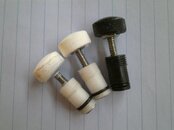Currently in the works. Pictures and instructions to follow. As of this time I have a functional, but not fully finished model.
PM me if you are interested in one of a limited number of Beta test adjustment knobs. Only cost will be positive or negative feedback on this thread.
PM me if you are interested in one of a limited number of Beta test adjustment knobs. Only cost will be positive or negative feedback on this thread.





